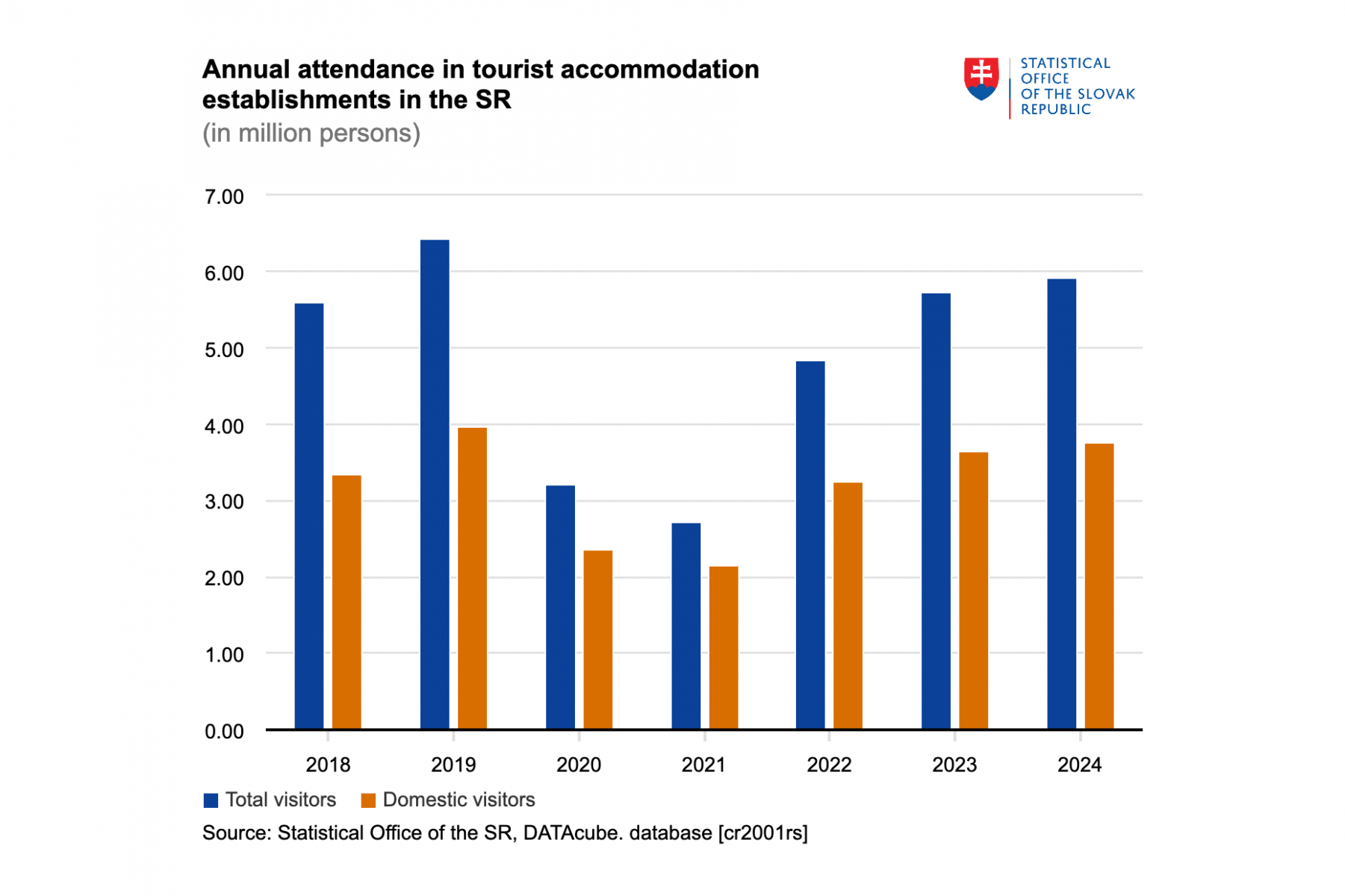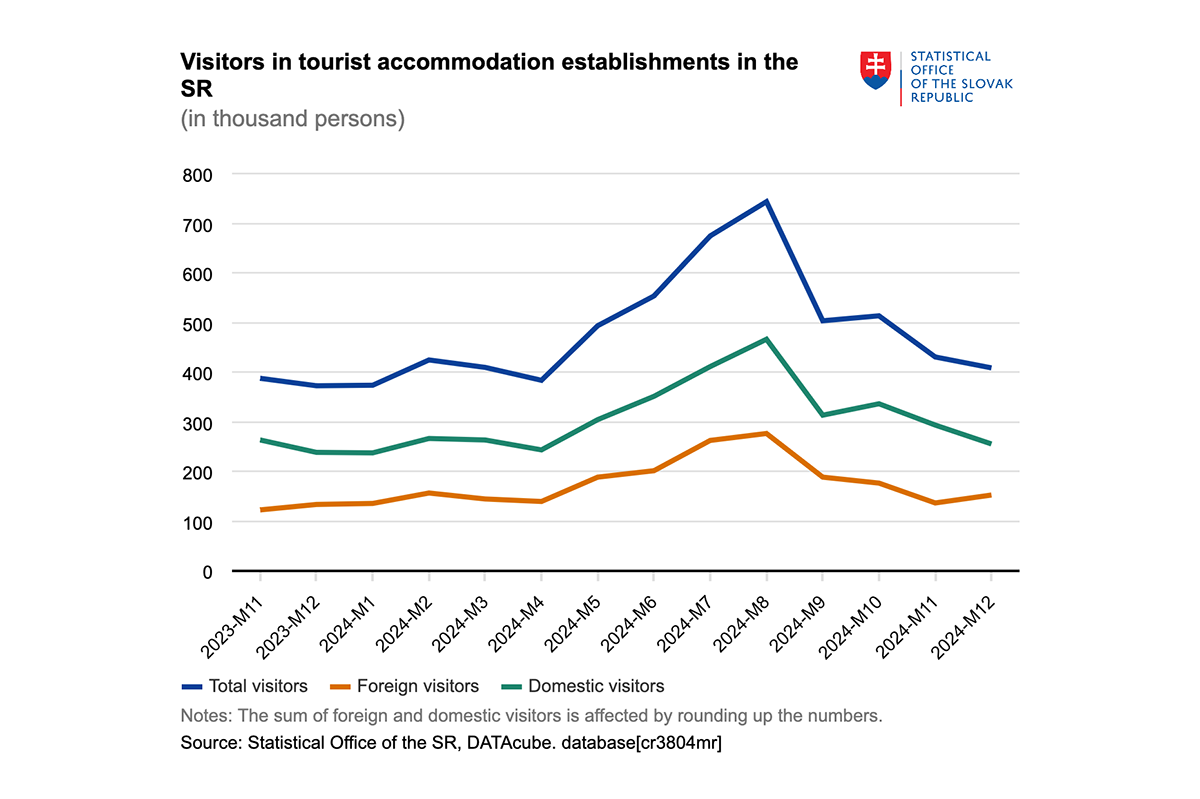Slovak tourism sees growth in 2024 but still below pre-pandemic levels
Slovakia’s tourism sector continued its gradual recovery in 2024, recording 5.9 million visitors to accommodation establishments, a 3% increase year-on-year. However, the total number of guests remained 516,000 below pre-pandemic levels, with the industry still struggling to return to its record-breaking 2019 figures, when 6.4 million tourists visited Slovakia.
December 2024: Strong End to the Year
The final month of the year saw 409,000 guests stay in hotels and guesthouses across Slovakia, marking a nearly 10% increase compared to December 2023. Despite this growth, visitor numbers remained 6% below December 2019, with around 26,000 fewer guests. Visitors spent over 925,000 nights in accommodation establishments, with an average stay of 2.3 nights.
Domestic tourists accounted for almost two-thirds of December visitors, reaching 256,000—a 7% increase year-on-year. The number of foreign visitors grew by 14%, with 153,000 international guests choosing Slovakia as their destination.
Regional Tourism Trends in December 2024
Six out of Slovakia’s eight regions saw a year-on-year rise in visitors, with increases ranging from 3.3% to 23.5%. The Banskobystrický and Košický regions experienced the most significant growth, both exceeding 23% compared to the previous year. Žilinský and Prešovský regions not only saw growth but also surpassed their December 2019 visitor levels. However, Trnavský and Trenčiansky regions recorded a decline of up to 5%.
The most visited region in December was Bratislavský kraj, which hosted 118,000 guests, nearly half of all foreign visitors. It was followed by Žilinský (90,000 visitors), Prešovský (76,000 guests), and Banskobystrický kraj (45,000 visitors).
Full-Year 2024 Tourism Performance
Across 2024, Slovak hotels and guesthouses hosted 5.9 million tourists, the second-highest number in history, but still 8% below the record 6.4 million visitors in 2019. While domestic tourism showed resilience, foreign visitor numbers remained significantly lower than pre-pandemic levels.
Domestic travelers made up 3.8 million of the total visitors, while foreign tourists accounted for 2.2 million guests. While both figures showed slight year-on-year growth, Slovakia still saw 310,000 fewer foreign visitors than in 2019, marking a 13% decline in international tourism compared to pre-pandemic levels.
On a regional level, tourism increased in all eight Slovak regions, with growth rates of up to 8% year-on-year, setting new post-pandemic records for both domestic and foreign visitors. Žilinský kraj stood out, achieving its highest-ever foreign visitor numbers, even surpassing 2019 levels. However, it was the only region where domestic tourism declined.
The Bratislavský and Žilinský regions remained Slovakia’s most visited destinations, collectively welcoming over 2.7 million guests in 2024. Prešovský kraj also exceeded the one-million visitor mark. Despite the growth, several regions—including Bratislavský, Trenčiansky, Nitriansky, and Banskobystrický kraj—remained more than 10% below their pre-pandemic visitor levels. In contrast, Žilinský and Prešovský regions came the closest to full recovery, missing just 4% of their 2019 visitor numbers.
While the Slovak tourism sector made notable gains in 2024, it has yet to fully recover from the effects of the pandemic. The industry remains on a steady upward trajectory, with domestic tourism continuing to drive growth and international arrivals gradually improving.
Source: Statistical Office of the SR










